Subsurface Banding of Poultry Manure Enhances Photosynthetic Efficiency, Yield, and Nutrient Uptake in Buckwheat
Abstract
1. Introduction
2. Results
2.1. Plant Growth Parameters
2.2. Seed Productivity
2.3. Seed Nutrient Value
3. Discussion
3.1. Effect of Fertilizer Application Methods on Photosynthetic Pigments and Anthocyanin
3.2. Effect of Fertilizer Application Methods on Growth Parameters
3.3. Effects of Fertilizer Application Methods on Yield Components and Seed Yield
3.4. Effect of Fertilizer Application Methods on Seed Macronutrient Content
4. Materials and Methods
4.1. Site Description and Climatic Properties
4.2. Field Operations and Treatments
4.3. Measurements
4.3.1. Chlorophyll Determination
4.3.2. Carotenoid and Anthocyanin Estimations
4.3.3. Leaf Area Index Measurement
4.3.4. Dry Matter (DM)
4.3.5. Plant Height and Branches Number
4.3.6. Yield and Yield Components
4.3.7. Seed Macronutrient Concentration
4.4. Statistical Analysis
5. Conclusions
Supplementary Materials
Author Contributions
Funding
Data Availability Statement
Acknowledgments
Conflicts of Interest
References
- Rosentrater, K.A.; Palmade, L.; Kongar, E. Editorial: Nutrition at the crossroads: Food at the intersection of environmental, economic, and social sustainability. Front. Nutr. 2019, 6, 158. [Google Scholar] [CrossRef]
- Çakmakçı, R.; Salık, M.A.; Çakmakçı, S. Assessment and principles of environmentally sustainable food and agriculture systems. Agriculture 2023, 13, 1073. [Google Scholar] [CrossRef]
- Latini, A.; Giagnacovo, G.; Campiotti, C.A.; Bibbiani, C.; Mariani, S. A narrative review of the facts and perspectives on agricultural fertilization in Europe, with a focus on Italy. Horticulturae 2021, 7, 158. [Google Scholar] [CrossRef]
- Wang, J.; Cui, W.; Che, Z.; Liang, F.; Wen, Y.; Zhan, M.; Dong, X.; Jin, W.; Dong, Z.; Song, H. Effects of synthetic nitrogen fertilizer and manure on fungal and bacterial contributions to N2O production along a soil acidity gradient. Sci. Total Environ. 2021, 753, 142011. [Google Scholar] [CrossRef] [PubMed]
- Gao, H.; Xi, Y.; Wu, X.; Pei, X.; Liang, G.; Bai, J.; Song, X.; Zhang, M.; Liu, X.; Han, Z.; et al. Partial substitution of manure reduces nitrous oxide emission with maintained yield in a winter wheat crop. J. Environ. Manag. 2023, 326, 116794. [Google Scholar] [CrossRef] [PubMed]
- Salehi, A.; Fallah, S.; Kaul, H.P. Broiler litter and inorganic fertilizer effects on seed yield and productivity of buckwheat and fenugreek in row intercropping. Arch. Agron. Soil Sci. 2017, 63, 1121–1136. [Google Scholar] [CrossRef]
- Salehi, A.; Fallah, S.; Kaul, H.P.; Zitterl-Eglseer, K. Antioxidant capacity and polyphenols in buckwheat seeds from fenugreek/buckwheat intercrops as influenced by fertilization. J. Cereal Sci. 2018, 84, 142–150. [Google Scholar] [CrossRef]
- Badagliacca, G.; Testa, G.; La Malfa, S.G.; Cafaro, V.; Lo Presti, E.; Monti, M. Organic fertilizers and bio-waste for sustainable soil management to support crops and control greenhouse gas emissions in Mediterranean agroecosystems: A Review. Horticulturae 2024, 10, 427. [Google Scholar] [CrossRef]
- Fallah, S.; Ghalavand, A.; Raiesi, F. Soil chemical properties and growth and nutrient uptake of maize grown with different combinations of broiler litter and chemical fertilizer in a calcareous soil. Commun. Soil Sci. Plant Anal. 2013, 44, 3120–3136. [Google Scholar] [CrossRef]
- Way, T.R.; Watts, D.B.; Tewolde, H.; Sistani, K.R.; Torbert, H.A. Implement with adjustable band spacing for subsurface band application of poultry litter. Appl. Eng. Agric. 2013, 29, 831–839. [Google Scholar] [CrossRef]
- Liu, J.; Kleinman, P.J.A.; Beegle, D.B.; Dell, C.J.; Veith, T.L.; Saporito, L.S.; Han, K.; Pote, D.H.; Bryant, R.B. Subsurface Application Enhances Benefits of Manure Redistribution. Agric. Environ. Lett. 2016, 1, 150003. [Google Scholar] [CrossRef]
- Tewolde, H.; Way, T.R.; Buehring, N.; Jenkins, J.N. Fertilizer value of poultry litter applied by subsurface band vs. surface broadcast in corn production. J. Plant Nutr. 2023, 46, 2044–2059. [Google Scholar] [CrossRef]
- Lamba, J.; Srivastava, P.; Way, T.R.; Sen, S.; Wood, C.W.; Yoo, K.H. Nutrient loss in leachate and surface runoff from surface-broadcast and subsurface-banded broiler litter. J. Environ. Qual. 2013, 42, 1574–1582. [Google Scholar] [CrossRef]
- Shah, S.B.; Shamblin, M.D.; Boone, H.N.; Gartin, S.A.; Bhumbla, D.K. Runoff water quality impacts of different turkey litter application methods. Appl. Eng. Agric. 2004, 20, 207–210. [Google Scholar] [CrossRef]
- Amin, Z.; Fallah, S.; Abbasi Surki, A. The effect of type and application method of fertilizer treatments on growth and yield of medicinal garlic. Iran J. Field Crop Res. 2017, 15, 185–203. [Google Scholar]
- Niu, J.; Liu, C.; Huang, M.; Liu, K.; Yan, D. Effects of foliar fertilization: A review of current status and future perspectives. J. Soil Sci. Plant Nutr. 2021, 21, 104–118. [Google Scholar] [CrossRef]
- El Sayed, S.; Bakry, A.B.; Nofal, O.A.; Horish, M.A. Effectiveness of biofertilizers foliar application on yield and quality traits of flax (Linum usitatissimum L.). Oil Crop Sci. 2024, 9, 91–101. [Google Scholar] [CrossRef]
- Sinkovič, L.; Kokalj, D.; Vidrih, R.; Meglič, V. Milling fractions fatty acid composition of common (Fagopyrum esculentum Moench) and tartary (Fagopyrum tataricum (L.) Gaertn) buckwheat. J. Stored Prod. Res. 2020, 85, 101551. [Google Scholar] [CrossRef]
- Huda, M.N.; Lu, S.; Jahan, T.; Ding, M.; Jha, R.; Zhang, K.; Zhang, W.; Georgiev, M.I.; Park, S.U.; Zhou, M. Treasure from garden: Bioactive compounds of buckwheat. Food Chem. 2021, 335, 127653. [Google Scholar] [CrossRef]
- Ji, X.; Han, L.; Liu, F.; Yin, S.; Peng, Q.; Wang, M. A mini-review of isolation, chemical properties and bioactivities of polysaccharides from buckwheat (Fagopyrum Mill). Int. J. Biol. Macromol. 2019, 127, 204–209. [Google Scholar] [CrossRef]
- Martins, T.; Barros, A.N.; Rosa, E.; Antunes, L. Enhancing health benefits through chlorophylls and chlorophyll-rich agro-food: A Comprehensive Review. Molecules 2023, 28, 5344. [Google Scholar] [CrossRef] [PubMed]
- Salehi, A.; Mehdi, B.; Fallah, S.; Kaul, H.P.; Neugschwandtner, R.W. Productivity and nutrient use efficiency with integrated fertilization of buckwheat–fenugreek intercrops. Nutr. Cycl. Agroecosyst. 2018, 110, 407–425. [Google Scholar] [CrossRef]
- Hric, P.; Vozár, Ľ.; Kovár, P. The changes of the assimilation pigments content of turf Festuca spp. leaves after application of different nutrition forms. Acta Fytotech. Zootech. 2018, 21, 6–10. [Google Scholar] [CrossRef][Green Version]
- Al-Gaadi, K.A.; Madugundu, R.; Tola, E. Investigating the response of soil and vegetable crops to poultry and cow manure using ground and satellite data. Saudi J. Biol. Sci. 2019, 26, 1392–1399. [Google Scholar] [CrossRef]
- Ma, Q.; Tang, H.; Rengel, Z.; Shen, J. Banding phosphorus and ammonium enhances nutrient uptake by maize via modifying root spatial distribution. Crop Pasture Sci. 2013, 64, 965. [Google Scholar] [CrossRef]
- Simkin, A.J.; Kapoor, L.; Doss, C.G.P.; Hofmann, T.A.; Lawson, T.; Ramamoorthy, S. The role of photosynthesis related pigments in light harvesting, photoprotection and enhancement of photosynthetic yield in planta. Photosynth. Res. 2022, 152, 23–42. [Google Scholar] [CrossRef]
- Kaur, S.; Tiwari, V.; Kumari, A.; Chaudhary, E.; Sharma, A.; Ali, U.; Garg, M. Protective and defensive role of anthocyanins under plant abiotic and biotic stresses: An emerging application in sustainable agriculture. J. Biotechnol. 2023, 361, 12–29. [Google Scholar] [CrossRef]
- Fernández, V.; Brown, P.H. From plant surface to plant metabolism: The uncertain fate of foliar-applied nutrients. Front. Plant Sci. 2013, 4, 289. [Google Scholar] [CrossRef] [PubMed]
- Detpiratmongkol, S.; Ubolkerd, T.; Yoosukyingstaporn, S. Effects of chicken, pig and cow manures on growth and yield of Kalmegh (Andrographis paniculata Nees). J. Agric. Technol. 2014, 10, 475–482. [Google Scholar]
- Berdjour, A.; Dugje, I.Y.; Rahman, N.A.; Odoom, D.A.; Kamara, A.Y.; Ajala, S. Direct estimation of maize leaf area index as influenced by organic and inorganic fertilizer rates in Guinea Savanna. J. Agric. Sci. 2020, 12, 66. [Google Scholar] [CrossRef]
- Hsu, C.M.; Lai, H.Y. Comprehensive assessment of the influence of applying two kinds of chicken-manure-processed organic fertilizers on soil properties, mineralization of nitrogen, and yields of three crops. Agronomy 2022, 12, 2355. [Google Scholar] [CrossRef]
- Zubuko, N.S.; Olaleye, A.O.; Edje, O.T. Effects and rates of broiler and layer manures on the leaf yield and tissue nutrient contents of moringa (Moringa oleifera Lam.) in Swaziland. J. Plant Nutr. 2019, 42, 2323–2336. [Google Scholar] [CrossRef]
- Yaldız, G.; Çamlıca, M.; Özen, F.; Eratalar, S.A. Effect of poultry manure on yield and nutrient composition of sweet basil (Ocimum basilicum L.). Commun. Soil Sci. Plant Anal. 2019, 50, 838–852. [Google Scholar] [CrossRef]
- Pote, D.H.; Way, T.R.; Kleinman, P.J.A.; Moore, P.A. Subsurface application of dry poultry litter: Impacts on common bermudagrass and other no-till crops. J. Agric. Sci. 2012, 4, 55–62. [Google Scholar] [CrossRef]
- Arancon, N.Q.; Edwards, C.A.; Bierman, P.; Welch, C.; Metzger, J.D. Influences of vermi composts on field strawberries: 1. Effects on growth and yields. Bioresour. Technol. 2004, 93, 145–153. [Google Scholar] [CrossRef] [PubMed]
- Rostaei, M.; Fallah, S.; Abbasi Surki, A. Effect of fertilizer sources on growth, yield and yield components of fenugreek intercropped with black cumin. J. Crop Prod. 2015, 7, 197–222. [Google Scholar]
- Khatate, S.V.; Patil, A.V.; Jadhav, A.B.; Phalke, D.H.; Pachpute, S.T. Growth, nutrient uptake and yield of wheat as influenced by foliar sprays of cattle urine and nitrogen. Int. J. Plant Soil Sci. 2021, 33, 29–41. [Google Scholar] [CrossRef]
- Basay, S.; Dorak, S.; Aşik, B.B. The Effects of Organic Fertilizer Applications on the Nutrient Elements Content of Eggplant Seeds. Agronomy 2025, 15, 439. [Google Scholar] [CrossRef]
- Yürürdurmaz, C. Impact of Different Fertilizer Forms on Yield Components and Macro–Micronutrient Contents of Cowpea (Vigna unguiculata L.). Sustainability 2022, 14, 12753. [Google Scholar] [CrossRef]
- Ashworth, A.J.; Amorim, H.; Moore, P.A.; Adams, T.A.; Nieman, C.; Owens, P.R. Nutrient transformations based on sampling scheme and cropping system following subsurface-banded poultry litter. Soil Sci. Soc. Am. J. 2024, 88, 1285–1296. [Google Scholar] [CrossRef]
- Rayne, N.; Aula, L. Livestock manure and the impacts on soil health: A review. Soil Syst. 2020, 4, 64. [Google Scholar] [CrossRef]
- Tawfik, A.; Eraky, M.; Osman, A.I.; Ai, P.; Zhou, Z.; Meng, F.; Rooney, D.W. Bioenergy production from chicken manure: A review. Environ. Chem. Lett. 2023, 21, 2707–2727. [Google Scholar] [CrossRef]
- Wang, Q.; Li, S.; Li, J.; Huang, D. The utilization and roles of nitrogen in plants. Forests 2024, 15, 1191. [Google Scholar] [CrossRef]
- Mondol, A.T.M.A.I.; Chowdhury, M.A.H.; Ahmed, S.; Alam, M.K. Nitrogen dynamics from conventional organic manures as influenced by different temperature regimes in subtropical conditions. Nitrogen 2024, 5, 746–762. [Google Scholar] [CrossRef]
- Alizadeh, P.; Fallah, S.; Raeisi, F. Potential N mineralization and availability to irrigated maize in a calcareous soil amended with organic manures and urea under field conditions. Int. J. Plant Prod. 2012, 6, 493–512. [Google Scholar]
- Duan, Y.; Xu, M.; Gao, S.; Yang, X.; Huang, S.; Liu, H.; Wang, B. Nitrogen use efficiency in a wheat–corn cropping system from 15 years of manure and fertilizer applications. Field Crops Res. 2014, 157, 47–56. [Google Scholar] [CrossRef]
- Singh, K.; Chand, S.; Yaseen, M. Integrated nutrient management in Indian basil (Ocimum basilicum). Ind. Crops Prod. 2014, 55, 225–229. [Google Scholar] [CrossRef]
- Basílio, F.; Dias, T.; Santana, M.; Melo, J.; Carvalho, L.; Correia, P.; Cruz, C. Multiple modes of action are needed to unlock soil phosphorus fractions unavailable for plants: The example of bacteria- and fungi-based biofertilizers. Appl Soil Ecol. 2022, 178, 104550. [Google Scholar] [CrossRef]
- Rafiullah; Khan, M.J.; Muhammad, D.; Mussarat, M.; Huma Adnan, M.; Fahad, S.; Wahid, F.; Arif, M.; Amanullah, Jr. Foliar versus soil phosphorus (P) application for improving P use efficiency in wheat and maize in calcareous soils. J. Plant Nutr. 2021, 44, 1598–1610. [Google Scholar] [CrossRef]
- Hasanuzzaman, M.; Bhuyan, M.H.M.B.; Nahar, K.; Hossain, M.S.; Mahmud, J.A.; Hossen, M.S.; Masud, A.A.C.; Moumita; Fujita, M. Potassium: A vital regulator of plant responses and tolerance to abiotic stresses. Argonomy 2018, 8, 31. [Google Scholar] [CrossRef]
- Hulugalle, N.R.; McCorkell, B.E.; Weaver, T.B.; Finlay, L.A. Managing sodicity and exchangeable K in a dryland vertisol in Australia with deep tillage, cattle manure, and gypsum. Arid Land Res. Manag. 2010, 24, 181–195. [Google Scholar] [CrossRef]
- Rhoades, J.D. Electrical conductivity and total dissolved soilds. In Methods of Soil Analysis; Sparks, D.L., Ed.; Part 3. Chemical Methods; SSSA: Madison, WI, USA, 1996; pp. 417–435. [Google Scholar]
- Walkley, A.; Black, I.A. An examination of the Degtjareff method for determining soil organic matter, and a proposed modification of the chromic acid titration method. Soil Sci. 1934, 37, 29–38. [Google Scholar] [CrossRef]
- Bremner, J.M. Nitrogen-Total. In Methods of Soil Analysis; Sparks, D.L., Ed.; Part 3. SSSA Book Ser. 5; SSSA: Madison, WI, USA; ASA: Madison, WI, USA, 1996; pp. 1085–1121. [Google Scholar] [CrossRef]
- Olsen, S.R.; Sommers, L.E. Phosphorus. In Methods of Soil Analysis, Part 2. Chemical and Microbiological Properties; Page, A.L., Miller, R.H., Keeney, D.R., Eds.; American Society of Agronomy Madison: Madison, WI, USA; SSSA: Madison, WI, USA, 1982; pp. 403–430. [Google Scholar] [CrossRef]
- Simard, R.R. Ammonium acetate-extractable elements. In Soil Sampling and Methods of Analysis; Carter, M.R., Ed.; Lewis Publishers: Boca Raton, FL, USA, 1993; pp. 39–42. [Google Scholar]
- Lindsay, W.L.; Norvell, W.A. Development of a DTPA soil test for zinc, iron, manganese, and copper. Soil Sci Soc Am. J. 1978, 42, 421–428. [Google Scholar] [CrossRef]
- Porra, R.J. The chequered history of the development and use of simultaneous equations for the accurate determination of chlorophylls a and b. Photosynth. Res. 2002, 73, 149–156. [Google Scholar] [CrossRef]
- Sims, D.A.; Gamon, J.A. Relationships between leaf pigment content and spectral reflectance across a wide range of species, leaf structures and developmental stages. Remote Sens. Environ. 2002, 81, 337–354. [Google Scholar] [CrossRef]
- Jiang, J.; Weiss, M.; Liu, S.; Baret, F. Effective GAI is best estimated from reflectance observations as compared to GAI and LAI: Demonstration for wheat and maize crops based on 3D radiative transfer simulations. Field Crop Res. 2022, 283, 108538. [Google Scholar] [CrossRef]
- Fallah, S.; Maggi, F.; Ghanbari-Odivi, A.; Rostaei, M. Optimizing Lemon Balm (Melissa officinalis L.) Cultivation: Effects of Different Manures on Plant Growth and Essential Oil Production During Consecutive Harvests. Horticulturae 2024, 10, 1105. [Google Scholar] [CrossRef]
- Babicki, S.; Arndt, D.; Marcu, A.; Liang, Y.; Grant, J.R.; Maciejewski, A.; Wishart, D.S. Heatmapper: Web-enabled heat mapping for all. Nucleic Acids Res. 2016, 44, 147–153. [Google Scholar] [CrossRef]
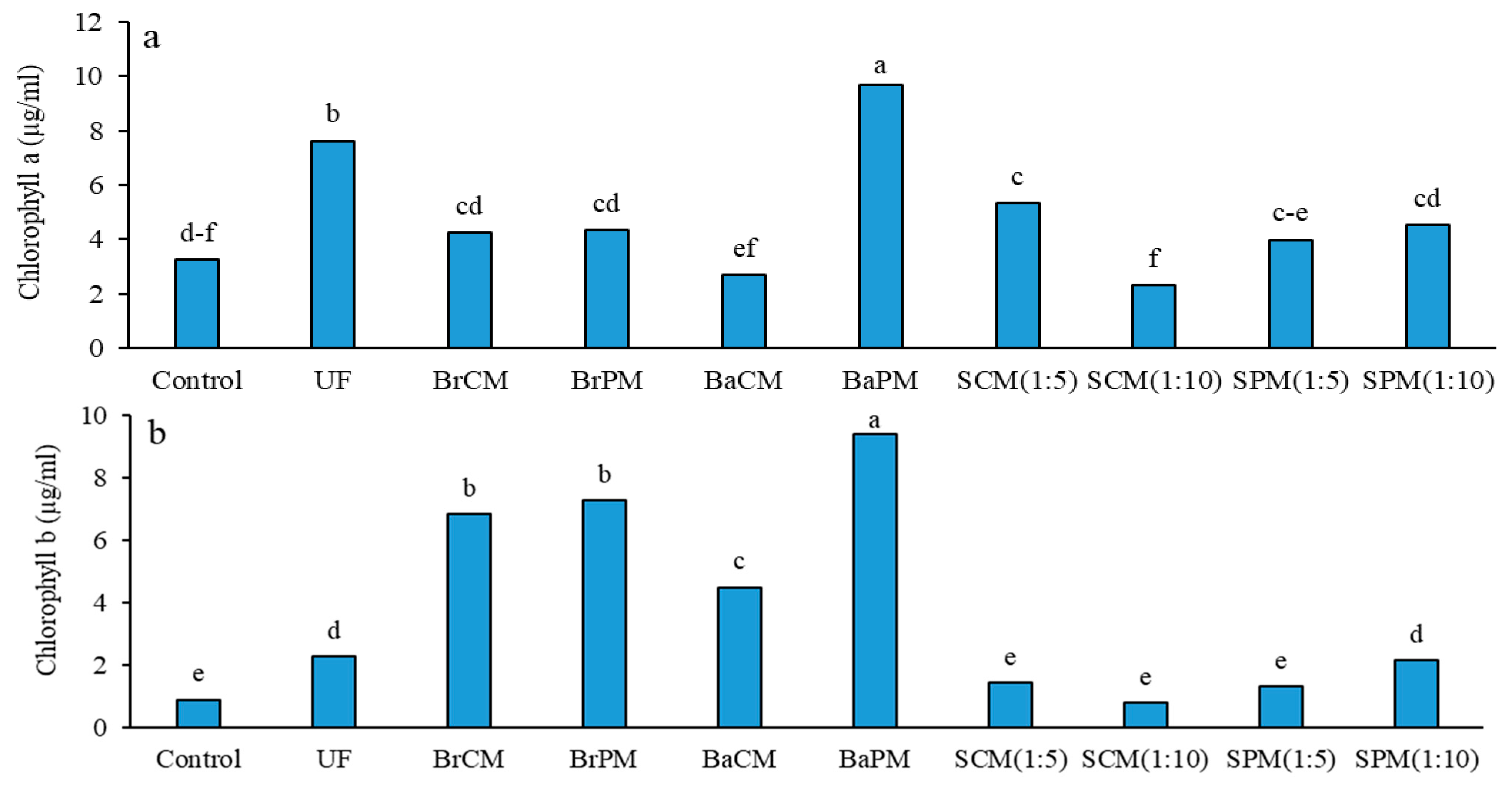




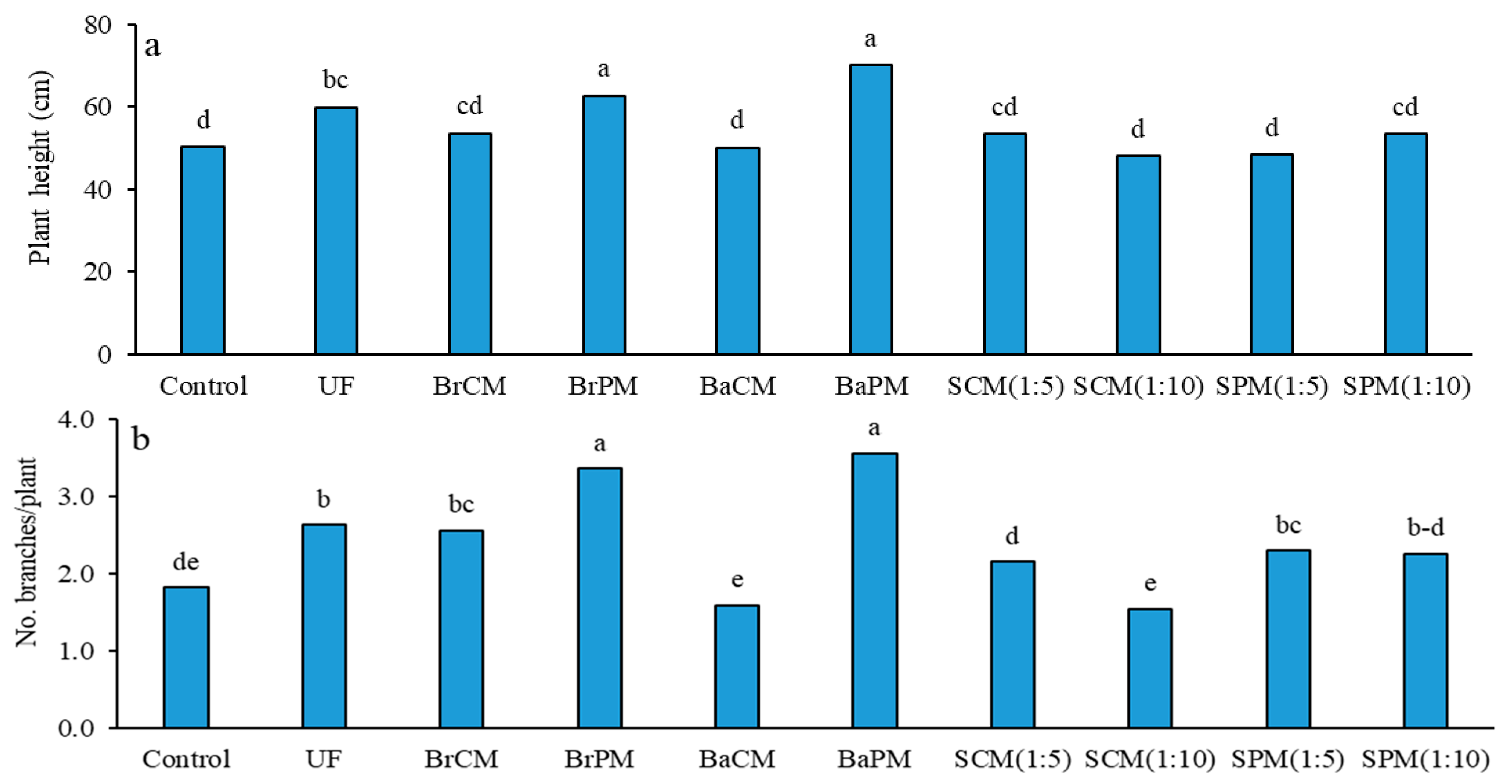
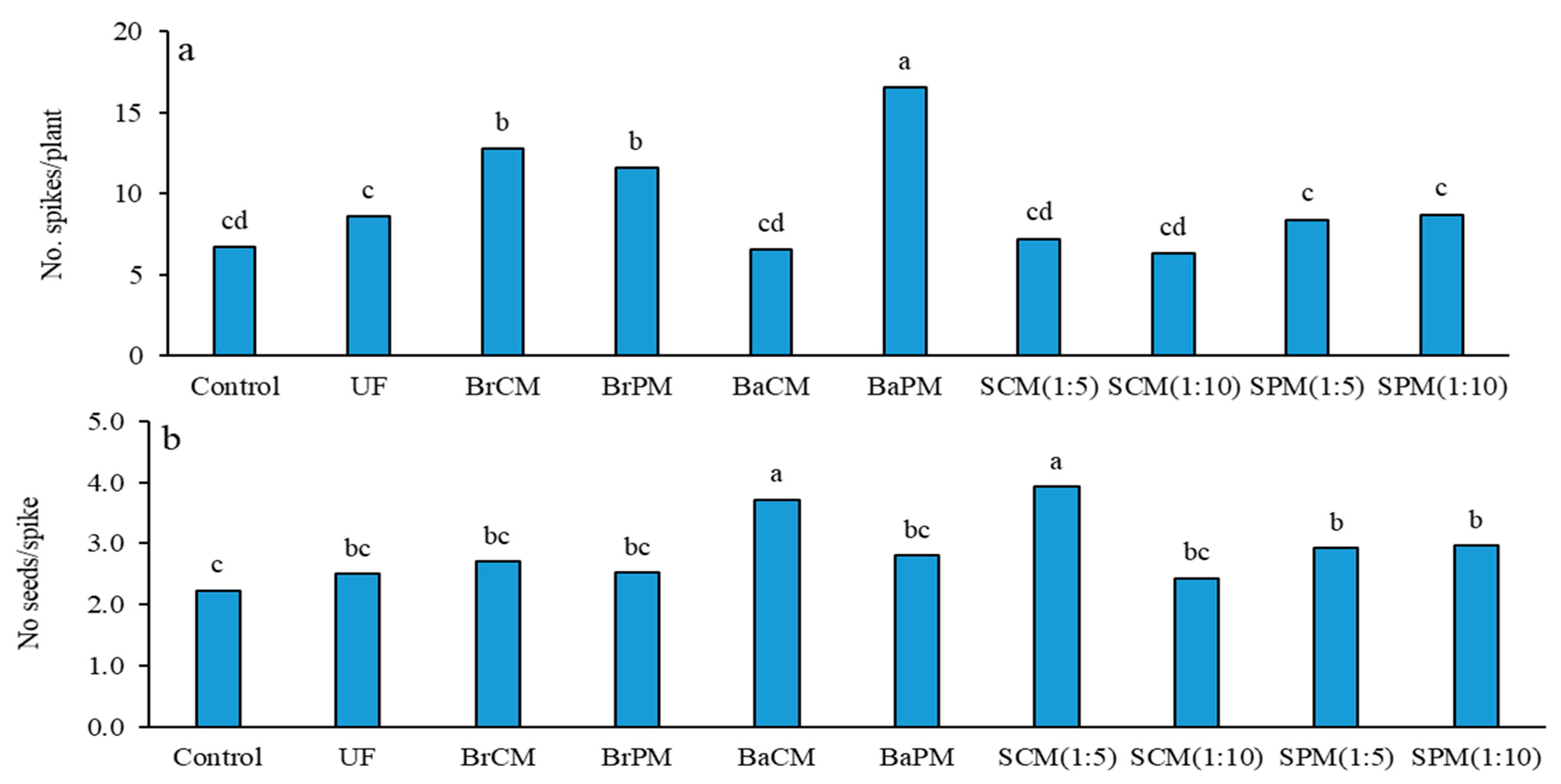

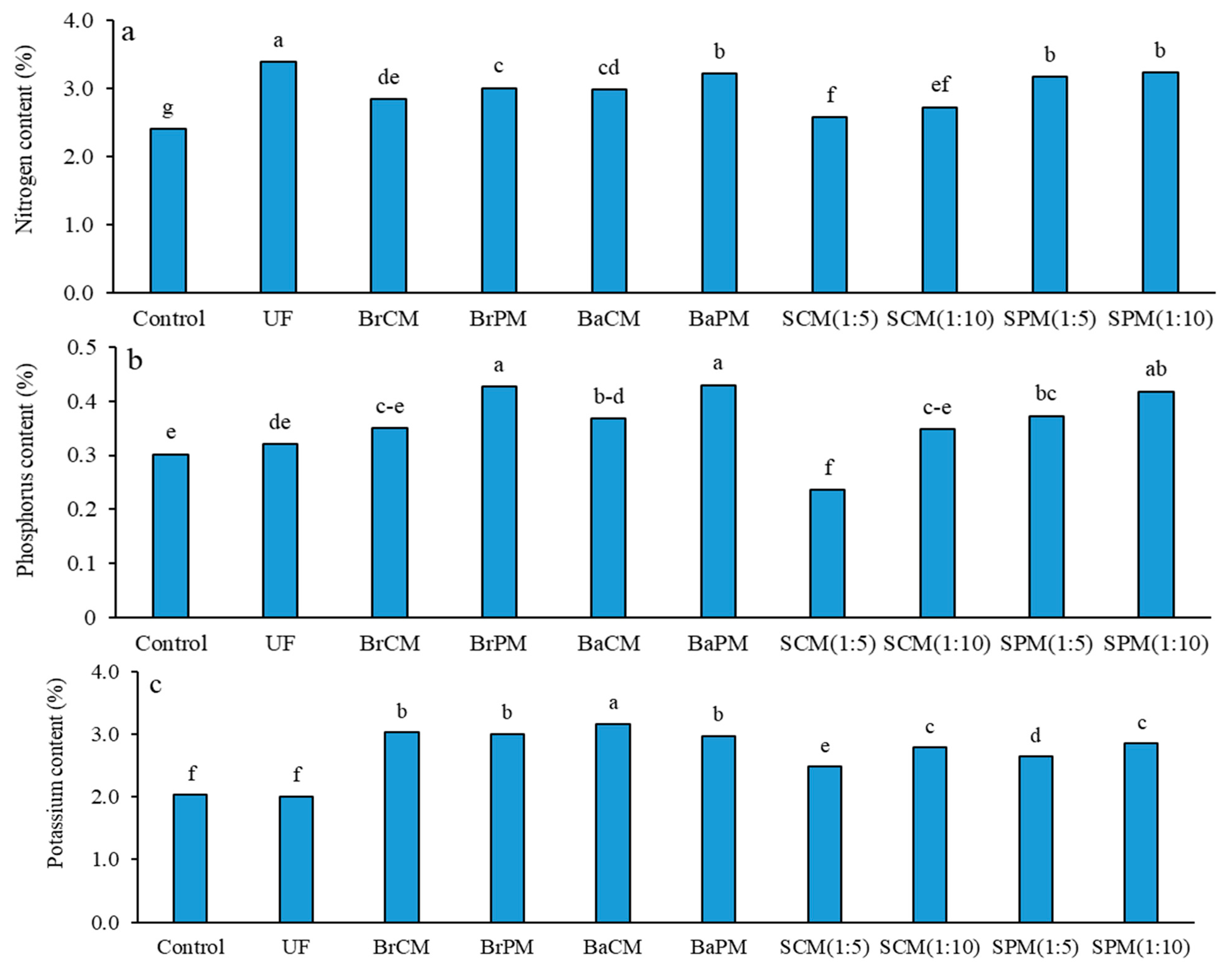
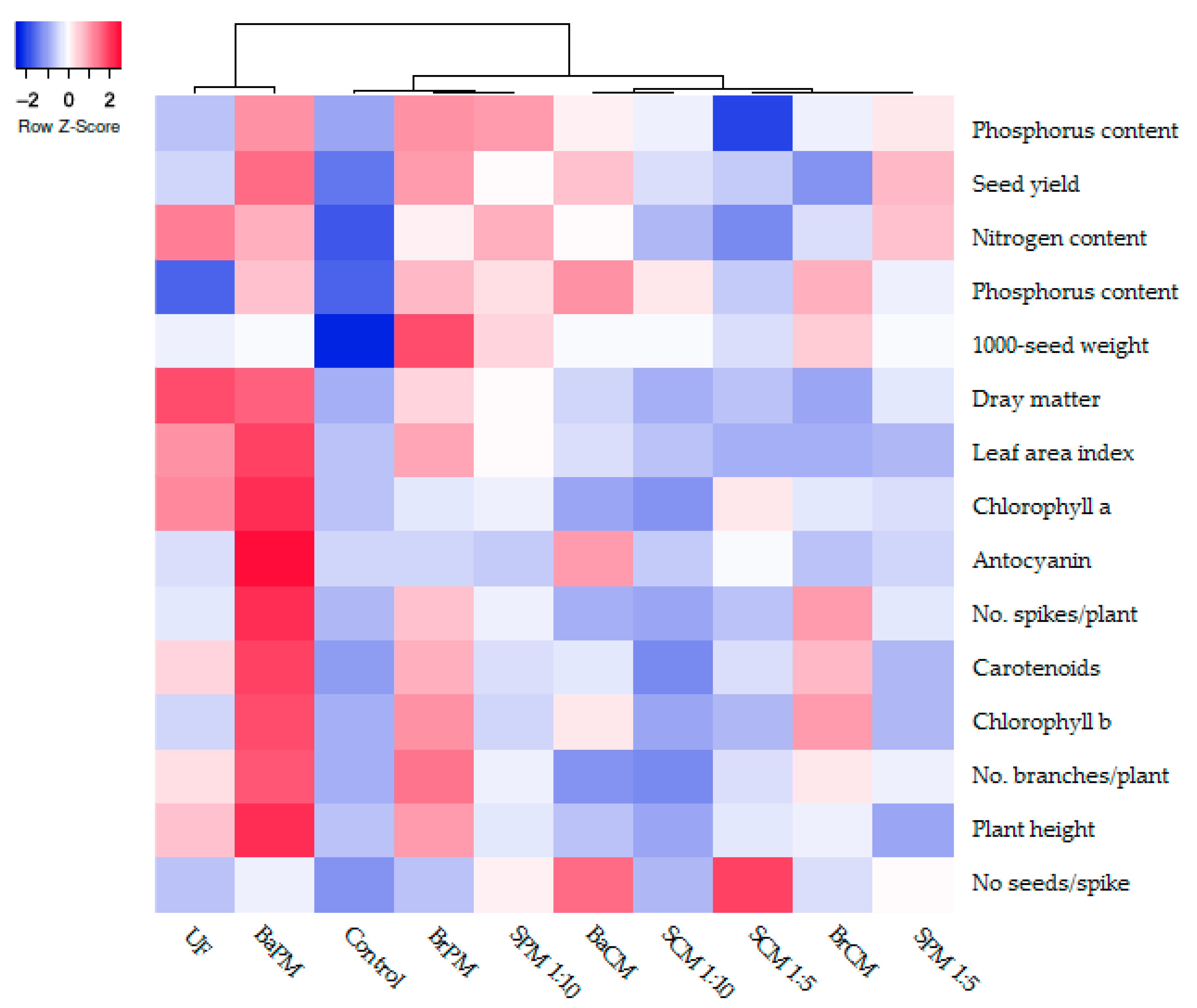
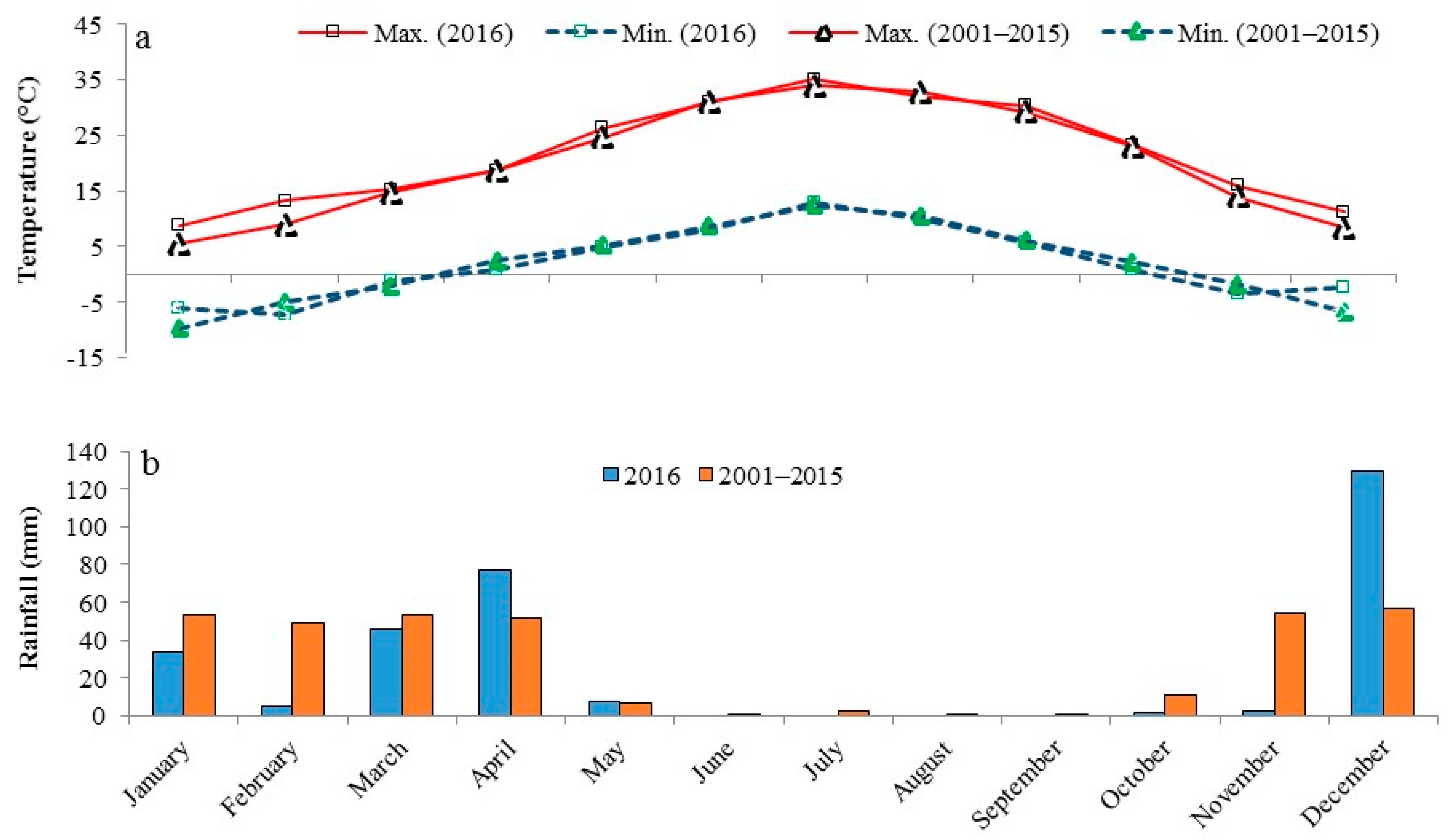
| Parameter | Unit | Soil | Poultry Manure (PM) | Cattle Manure (CM) | PM Extract (1:5) | PM Extract (1:10) | CM Extract (1:5) | CM Extract (1:10) |
|---|---|---|---|---|---|---|---|---|
| EC | µS/cm | 4000 | 8650 | 11,360 | 11,170 | 6740 | 14,060 | 12,300 |
| pH | - | 7.81 | 6.76 | 5.86 | 8.45 | 8.46 | 5.05 | 6.24 |
| Nitrogen | g/kg | 0.80 | 33.9 | 3.9 | 25.6 | 12.8 | 12.8 | 9.8 |
| Phosphorus | mg/kg | 15.3 | 16,100 | 9800 | 11,400 | 5700 | 5200 | 2600 |
| Potassium | mg/kg | 120 | 15,800 | 34,900 | 10,300 | 5100 | 16,400 | 8200 |
| Sodium | mg/kg | - | 1.99 | 1.98 | 2.36 | 1.18 | 2.97 | 1.48 |
| OC | g/kg | 7.0 | 69.5 | 17.5 | - | - | - | - |
| Iron | mg/kg | 0.03 | 976 | 324 | 922 | 461 | 812 | 406 |
| Zinc | mg/kg | 0.05 | 80.4 | 80.4 | 321 | 160 | 115 | 57.0 |
| Copper | mg/kg | 0.08 | 86.0 | 19.0 | 63.0 | 31.5 | 30.0 | 14.5 |
| Manganese | mg/kg | 0.04 | 411 | 109 | 215 | 107 | 102 | 51.2 |
Disclaimer/Publisher’s Note: The statements, opinions and data contained in all publications are solely those of the individual author(s) and contributor(s) and not of MDPI and/or the editor(s). MDPI and/or the editor(s) disclaim responsibility for any injury to people or property resulting from any ideas, methods, instructions or products referred to in the content. |
© 2025 by the authors. Licensee MDPI, Basel, Switzerland. This article is an open access article distributed under the terms and conditions of the Creative Commons Attribution (CC BY) license (https://creativecommons.org/licenses/by/4.0/).
Share and Cite
Fallah, S.; Abedini Dastgerdi, H.; Kaul, H.-P.; Salehi, A. Subsurface Banding of Poultry Manure Enhances Photosynthetic Efficiency, Yield, and Nutrient Uptake in Buckwheat. Plants 2025, 14, 2700. https://doi.org/10.3390/plants14172700
Fallah S, Abedini Dastgerdi H, Kaul H-P, Salehi A. Subsurface Banding of Poultry Manure Enhances Photosynthetic Efficiency, Yield, and Nutrient Uptake in Buckwheat. Plants. 2025; 14(17):2700. https://doi.org/10.3390/plants14172700
Chicago/Turabian StyleFallah, Sina, Hossein Abedini Dastgerdi, Hans-Peter Kaul, and Aliyeh Salehi. 2025. "Subsurface Banding of Poultry Manure Enhances Photosynthetic Efficiency, Yield, and Nutrient Uptake in Buckwheat" Plants 14, no. 17: 2700. https://doi.org/10.3390/plants14172700
APA StyleFallah, S., Abedini Dastgerdi, H., Kaul, H.-P., & Salehi, A. (2025). Subsurface Banding of Poultry Manure Enhances Photosynthetic Efficiency, Yield, and Nutrient Uptake in Buckwheat. Plants, 14(17), 2700. https://doi.org/10.3390/plants14172700







